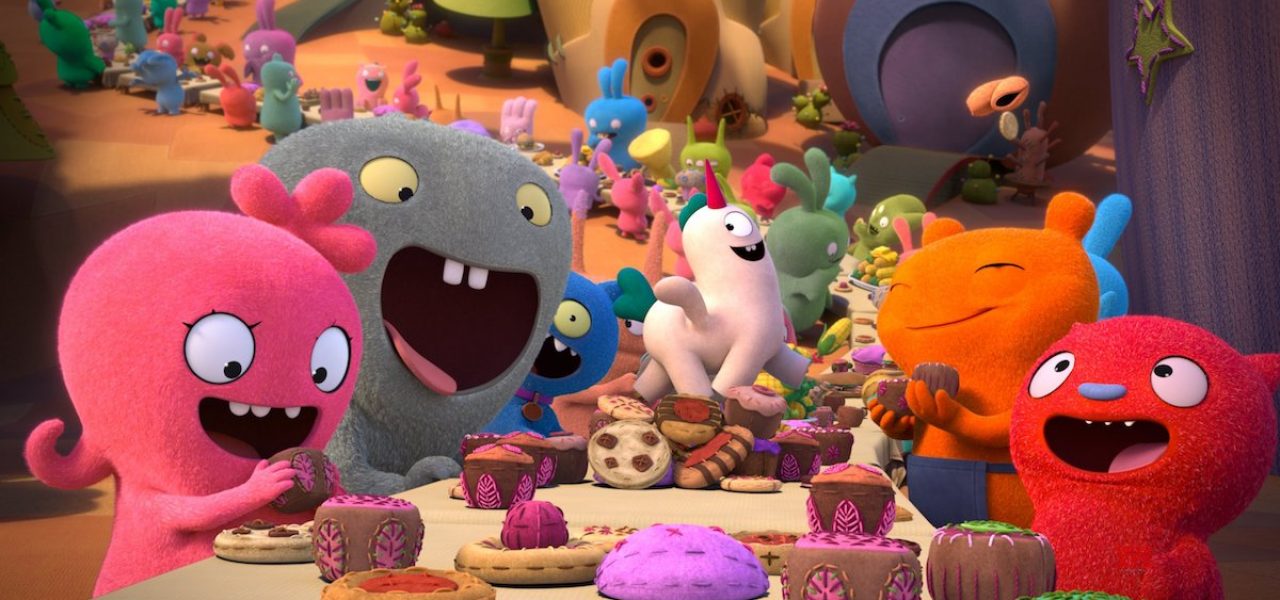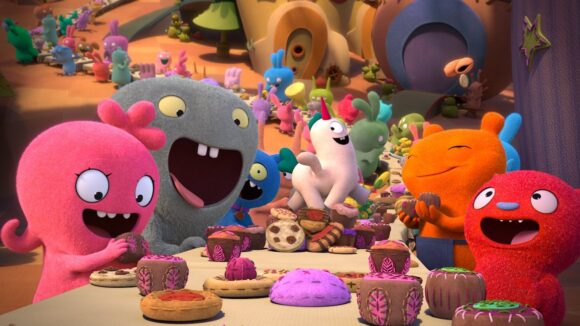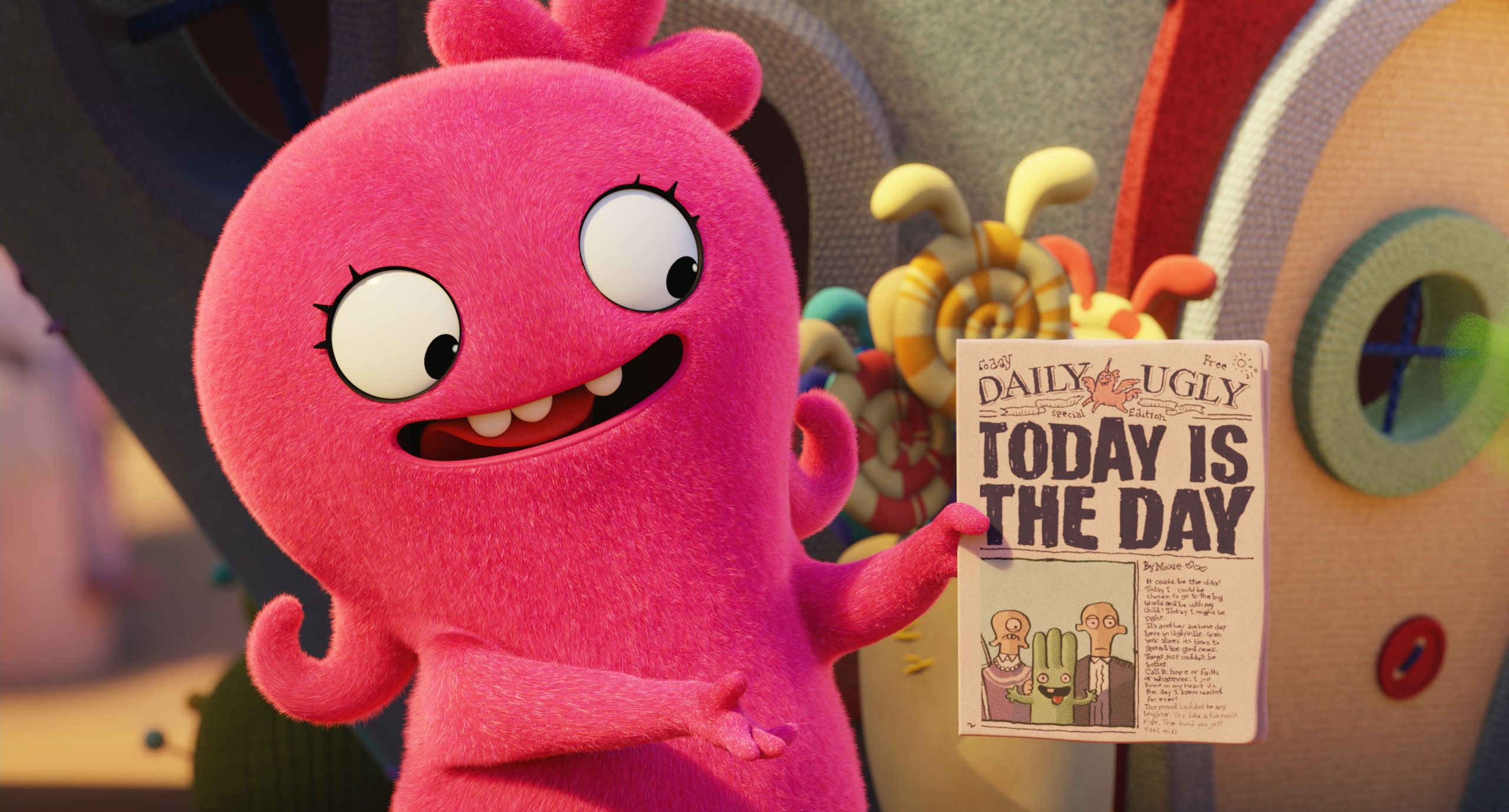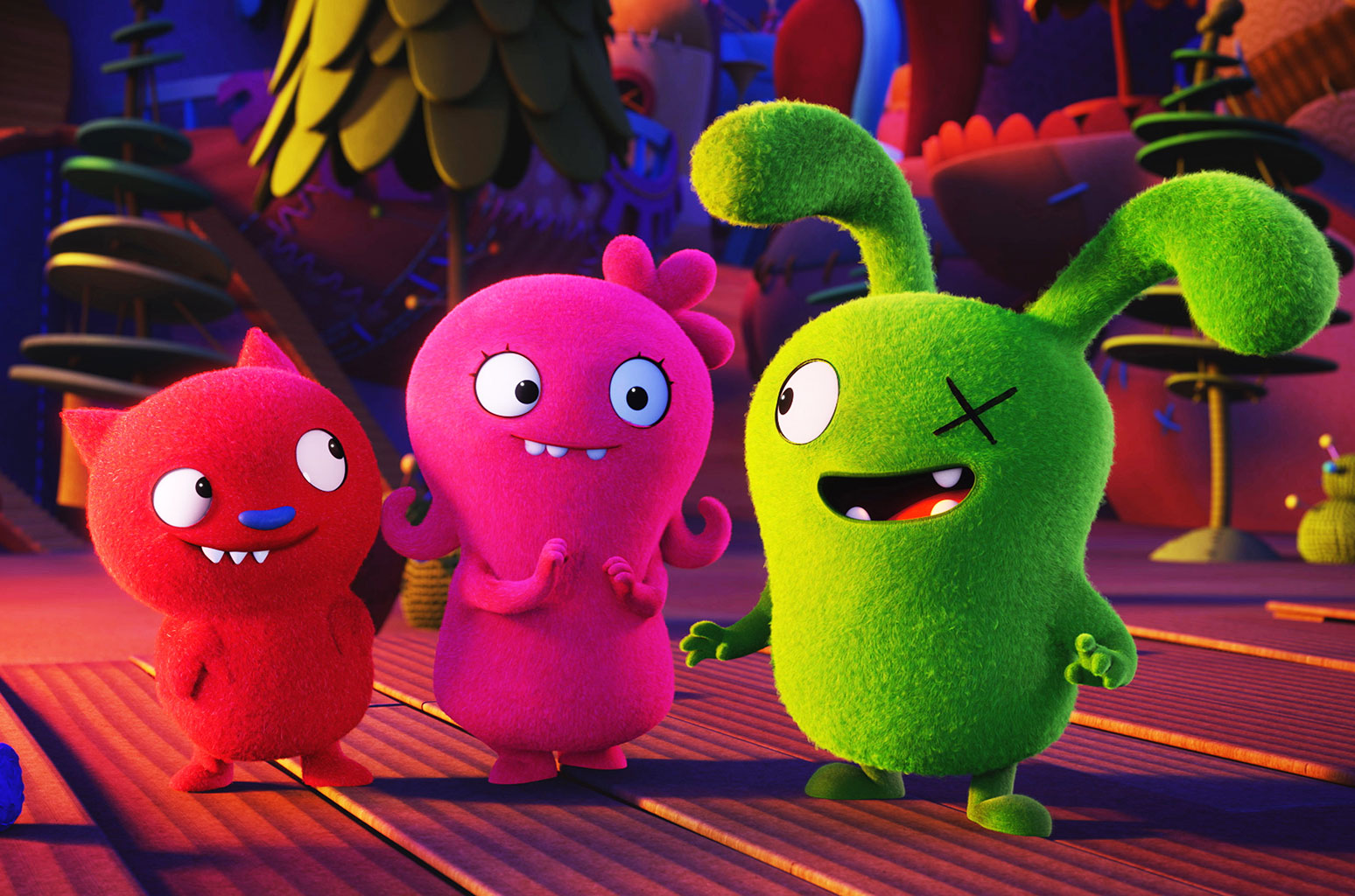

Kelly Asbury On Directing ‘Uglydolls’: “It Was Sort Of A Blank Slate, And That Was Great”
A career spanning over three decades has taken Oscar-nominated director Kelly Asbury (Spirit: Stallion of the Cimarron) from working as a visual development artist on classic hand-drawn Disney films like The Little Mermaid and Beauty and the Beast, to helping storyboard landmark stop motion projects like The Nightmare Before Christmas and James and the Giant Peach.
In the director’s chair, with the exception of Spirit, Asbury has mostly worked in cg features: Shrek 2, Gnomeo & Juliet, and Smurfs: The Lost Village. His latest, Uglydolls, is a musical adventure based on the plush toy line created by David Horvath and Sun-Min Kim, and follows a pack of colorful dolls that have been discarded for having peculiar or irregular features.
Through a series of songs performed by recognizable pop, rap, and country stars (Kelly Clarkson, Pitbull, Ice-T, Bebe Rexha, Blake Shelton, Janelle Monáe), the movie encourages self-esteem and the appreciation of others’ differences.
Animated across multiple production companies including Reel FX Animation in Montreal, Asbury often had to direct remotely, which was made possible thanks to digital tools that facilitated the interaction between him and his team regardless of physical distance. As someone who’s worked in the animation industry for several decades, Asbury is fascinated by the spontaneity that technology allows.
Chatting with Cartoon Brew in Los Angeles, the director shared his observation on the importance of the editorial team in an animated feature, why he felt Uglydolls needed to be a musical, and how the quality of the animation in the project surpassed his expectations.
Cartoon Brew: How did you come into this project following the Smurfs movie you did a few years back?

Kelly Asbury: Smurfs was really the first time in my career that I experienced what I would call a real bona fide box-office failure. I had never experienced that level of disappointment. Everything about it, to have that happen after all those years, is never fun; all these beautiful artists working together on something, and then it fizzles out.
So I took a little time off, and then I got a call from my attorney, and she said, “STX is looking for a director to help them get this movie made, and it’s called Uglydolls.” I had heard of it before, and I said, “I’ll go talk to them and I’ll see what it is.” It was really just one of those things where the timing was right, there was nothing else going on, I had a few irons in the fire that I was pitching around town, but this was something that was like, “Look, we need this now; we need to get going on it.”
It kind of was a challenge for me. I thought, “They’ve got a really good beginning and a great ending, so how do we now weave these together?” I like taking on something that’s not going to be that easy. That’s why I did Smurfs, because I thought, “Can we make a Smurfs film so that audiences will re-embrace the Smurfs after the two live-action hybrids?” And obviously, it didn’t quite work out, but I do like approaching things from, “What can be done here? What can be achieved here?”
Since a significant part of the movie was animated in Montreal, were you on site or directing remotely?
Kelly Asbury: Both. I directed remotely, I flew to Dallas, I flew to Montreal. It was a lot of traveling back and forth. I didn’t stay a long period of time anywhere. I went to Atlanta, Nashville, New York, Pittsburgh, and Philadelphia, all to get different actors. Once I started, it was all hands on deck from the very beginning. It was a lot of running around. It was a big 14 months.
How does the distance affect your process as a director, since you are not physically with the animators for extended periods of time?
Kelly Asbury: Trust. Luckily I had a great head of animation in Sébastien Bruneau and I had a great lighting guy at Reel FX. All these things came into play, and I simply had to make sure that I communicated clearly what was needed and what I wanted, and luckily I could draw things and do draw-overs, so I had that ability. It was a lot of just really keeping up with everything. Jane Hartwell, my producer, helped a lot with that, helped me stay organized, told me exactly what I needed to get done, who I need to talk to, who’s got a question. I kept the line of communication open 24-7 because we had people in China. In Nanjing, China, Original Force did some sequences for us, and Reel FX and I had to make sure that they were getting the communication that they needed, so it was constant.
In our recent interviews with animation directors, several of them have noted the important role of editorial in animated films, and how a lot of people don’t understand that it’s a process that happens prior to animating, which is very significant. What’s your take on that?
Kelly Asbury: Absolutely. When I work with an editor, I consider them a partner in making the movie. We had two lead editors on this movie, Julie Rogers and Nolan Southerland, and they were invaluable. Nolan was really great with music, and understanding how to weave a story together with songs, and Julie is just a really trained editor; she’s worked in live action and animation. We worked together to make decisions. I was constantly drawing in editorial. I would do thumbnails and we would put them in and see if they worked. When we got that together, we’d package it and send it to Reel FX, I would launch them, and they’d start the layout process, and we were working at a fast pace. But editorial is key. You can’t do it without them.
How has that process of editorial changed over the years, since you’ve worked in multiple techniques, in 2d and even stop motion to an extent?
Kelly Asbury: I don’t think it has. I think in film, in general, a director and an editor have to be really in line with each other. I’ve never done live action, but anyone I talk to that does live action, the relationship with the editor is key, because an editor really can see all the flaws, can see everything from a microvision, and as a director sometimes, I keep the big picture in mind. I paint with a broad brush, but there may be a continuity thing that an editor can spot and then we have to solve that problem. But sometimes, when you’re working on these animated features, keeping the big picture in mind is very important for a director. The details you get at as time passes. It’s nice to have an editor that’s kind of running interference and doing recon for you ahead of time, so that when they come they have a list of, “Here are some things that are not working yet,” so you can put your best foot forward at all times.

How has technology helped the process of pre-production, from storyboards to animatics, and knowing how it’s going to look before you animate in cg?
Kelly Asbury: For me, the Cintiq tablet, and being able to feed drawings immediately into the Avid. I can draw something and within 3 minutes the editor has it and we’re able to see the result. I remember the days when if you did a story sketch on a piece of paper, as much as I love drawing on paper, it would have to go be shot, sent to the lab, and the next day you would get to look at that one piece. The process has gotten very spontaneous because of the technology; before it just added time. I remember those days, I worked on those movies. On The Nightmare Before Christmas, that was the last one I worked on that was done on film, I remember Henry Selick needing a sketch to make something work. I would draw it, and I would send it off, and he wouldn’t know if he got the result until two days later, and he’d go, “No it didn’t work,” and I would have to do something else. It’s just so much different now in that way. Film is great, but I think technology is wonderful too.
Working in 2d in something like Spirit, how is the process different from working in cg? Is there something you enjoy more about either technique?
Kelly Asbury: From my standpoint, the most important thing and the thing I enjoy the most is the story development. The method by which the film is made, I hope it’s always the appropriate method. The 3d films that I’ve made, all of them were appropriately so. They weren’t that way just for the sake of being a 3d film. Spirit needed to be a 2d, hand-drawn animated film. It needed to have that craftsmanship. It would have looked strange, at least at that time. I don’t know how they could do it nowadays, but I wouldn’t want to do a super realistic version of Spirit because the story is not realistic; people would believe it less. It’s hard to say, it’s that fine line, but I never look back on Spirit and wish it was cg at all. I have not worked on one yet that’s cg that I wished was 2d, because they were appropriate for that. Shrek 2 and then Gnomeo and Juliet, all of those just felt right for cg animated films.
When you came on board Uglydolls were the songs already in place?
Kelly Asbury: No, it was my idea to make it a musical. I came in, and the story was pretty complicated. It had a lot of elements that you could see were great, it was like a lot of confetti. I loved the beginning, I loved the end, and I said, “What if to get this information, and to make it clearer, we use the device of music to do that. Let’s make it help us, make it work in our favor.” So we got Chris Lennertz and Glenn Slater, who are songwriters, to come in, and we worked closely with them. Our writer, Alison Peck, also worked with them. It was a collaboration to decide where those songs belonged, but everything was structured really like an old-fashioned Hollywood musical. In fact, that’s kind of what I said. I said, “Let’s pretend we’re telling this story in 1940, and we’re going to do this with music and songs,” and I’ve worked on a lot of musicals in animation, so it was fun to get back to that.

This surely influenced your decision to cast musicians for the voice cast. How was the process of working on their voice performances since many of them hadn’t done that before?
Kelly Asbury: Yeah, a lot of them had not necessarily been actors. The thing that’s great about doing animation is, first of all, the recording artists that we used, they’re very comfortable behind the microphone. They’re very comfortable, and they understand doing it over; they understand all the little fine pieces. When you hear a word that you wish was different, they hear you as if you were saying, “Can you go an octave higher? Can you change that note?” They understood the recording process better than some actors do. Some actors that are purely actors will say, “Do you need this again? Why do you need it again?” And they don’t understand that there’s little things that are different. Kelly Clarkson would give us as many takes as we wanted—she wanted more takes.
Since the dolls were a pre-existing toy line, how did you bring your own aesthetic and imprint into a movie like this?
Kelly Asbury: I talked to the creator, David Horvath, a little bit. I asked a lot of questions to STX who had been developing it for a while, and they had a few rules that we were supposed to live by, but there wasn’t really a sort of hard-and-fast bible to go by. It was just, they would tell me ideas that had been thrown about that people liked, but they were all over the place, so after a point I just said, “You know what, I’m going to approach this as if these characters are just blank slates,” and we did. Give or take a few little details about things that the property called for, there was nothing largely established that people expected from every character. It wasn’t like with Smurfs, where there was a thick bible, that was hard: Hefty can never say ‘this particular word’ and they always have to eat Smurfberries. We didn’t have any of that, so we made up rules and we created some things, but it was sort of a blank slate, and that was great.
On the visual side of the story, there are several textural elements on the characters because they’re dolls. What was the approach to those elements?
Kelly Asbury: Reel FX fortunately is a really great studio, and I could ask for something and they were able to deliver it to me to as satisfactory results as I think we could get with our time and budget. We tried to work within the limitations of what we had. We were not a high-budget film that was taking six years to be made, so there were things where we had to say, “Okay, let’s find a creative way to make this look as good as it can with the tools we’ve got. Reel FX is very good at that because they’ve done so many low-budget animated films and they’ve done commercials and they’ve done all sorts of small things for different movies, so they’ve learned techniques to get the most bang for their buck, if you will. They were great that way, and I’m very happy with the result that we got. To be honest, the movie looks better than I originally thought it would. I sort of said, “Okay, this is going to be something that’s not probably as rich as I would want it to be in most cases, but this is a different set of circumstances, [yet] it ended up being actually as rich. I feel like it’s as rich as anything I’ve directed in terms of look, so I was very happy with it.
STX Entertainment will open Uglydolls in the U.S on Friday, May 3.

.png)